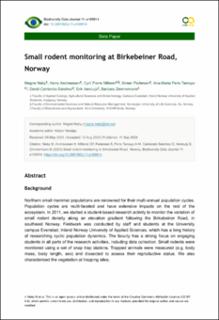| dc.contributor.author | Neby, Magne | |
| dc.contributor.author | Andreassen, Harry Peter | |
| dc.contributor.author | Milleret, Cyril Pierre | |
| dc.contributor.author | Pedersen, Simen | |
| dc.contributor.author | Tamayo, Ana-Maria | |
| dc.contributor.author | Sanchez, David Carricondo | |
| dc.contributor.author | Versluijs, Erik | |
| dc.contributor.author | Zimmermann, Barbara | |
| dc.coverage.spatial | Norway, Innlandet, Birkebeiner Road | en_US |
| dc.date.accessioned | 2023-09-15T10:00:05Z | |
| dc.date.available | 2023-09-15T10:00:05Z | |
| dc.date.created | 2023-08-14T15:21:36Z | |
| dc.date.issued | 2023 | |
| dc.identifier.issn | 1314-2836 | |
| dc.identifier.uri | https://hdl.handle.net/11250/3089686 | |
| dc.description.abstract | Background.
Northern small mammal populations are renowned for their multi-annual population cycles. Population cycles are multi-faceted and have extensive impacts on the rest of the ecosystem. In 2011, we started a student-based research activity to monitor the variation of small rodent density along an elevation gradient following the Birkebeiner Road, in southeast Norway. Fieldwork was conducted by staff and students at the University campus Evenstad, Inland Norway University of Applied Sciences, which has a long history of researching cyclic population dynamics. The faculty has a strong focus on engaging students in all parts of the research activities, including data collection. Small rodents were monitored using a set of snap trap stations. Trapped animals were measured (e.g. body mass, body length, sex) and dissected to assess their reproductive status. We also characterised the vegetation at trapping sites.
New information.
We provide a dataset of small rodent observations that show fluctuating population dynamics across an elevation gradient (300 m to 1,100 m a.s.l) and in contrasting habitats. This dataset encompasses three peaks of the typical 3-4-year vole population cycles; the number of small rodents and shrews captured show synchrony and peaked in years 2014, 2017 and 2021. The bank vole Myodes glareolus was by far (87%) the most common species trapped, but also other species were observed (including shrews). We provide digital data collection forms and highlight the importance of long-term data collection. | en_US |
| dc.language.iso | eng | en_US |
| dc.rights | Navngivelse 4.0 Internasjonal | * |
| dc.rights.uri | http://creativecommons.org/licenses/by/4.0/deed.no | * |
| dc.subject | arvicolinae | en_US |
| dc.subject | vole | en_US |
| dc.subject | shrews | en_US |
| dc.subject | trapping | en_US |
| dc.subject | occurrence | en_US |
| dc.subject | database | en_US |
| dc.subject | dissection | en_US |
| dc.title | Small rodent monitoring at Birkebeiner road, Norway | en_US |
| dc.type | Peer reviewed | en_US |
| dc.type | Journal article | en_US |
| dc.description.version | publishedVersion | en_US |
| dc.rights.holder | © Neby M et al. | en_US |
| dc.subject.nsi | VDP::Matematikk og Naturvitenskap: 400::Zoologiske og botaniske fag: 480::Økologi: 488 | en_US |
| dc.source.volume | 11 | en_US |
| dc.source.journal | Biodiversity Data Journal | en_US |
| dc.identifier.doi | 10.3897/BDJ.11.e105914 | |
| dc.identifier.cristin | 2166836 | |
| cristin.ispublished | true | |
| cristin.fulltext | original | |
| cristin.qualitycode | 1 | |

